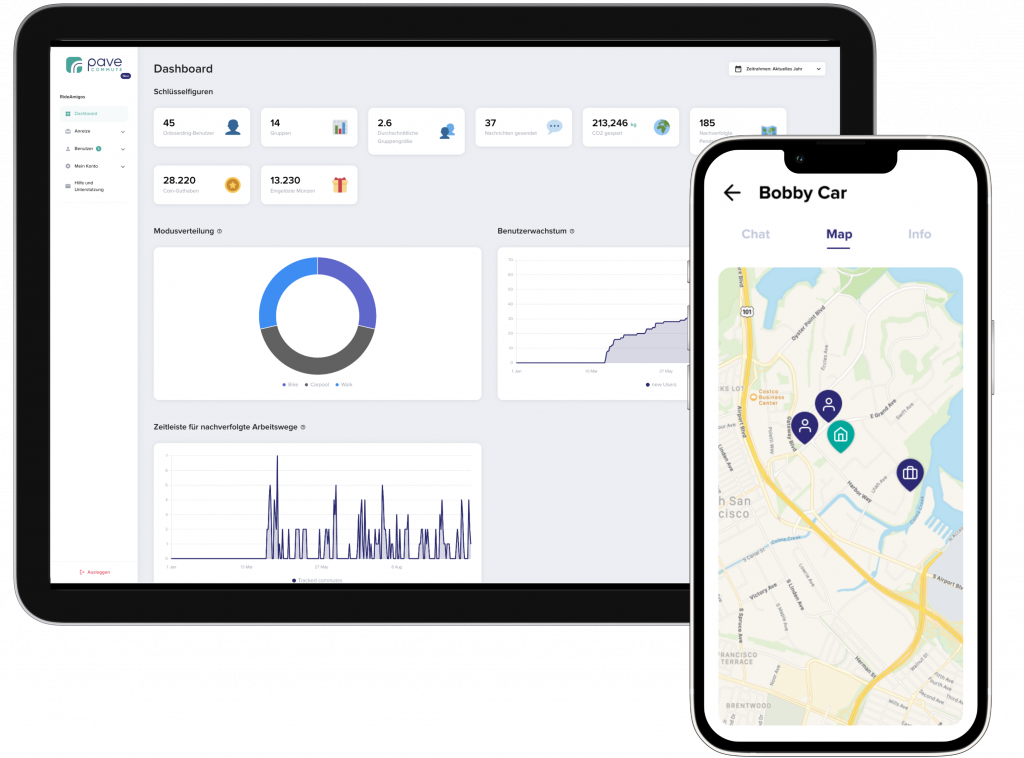Reducing carbon dioxide (CO2) emissions is a pressing global concern in the fight against climate change. Organizations have a significant role to play in this effort, and one impactful area where they can make a difference is in employee transportation. This article explores strategies and initiatives that businesses can implement to cut CO2 emissions from employee transportation, promoting sustainable commuting practices and contributing to a greener future.
Corporate accountability regarding emissions of greenhouse gasses
CO2 released by employee commuting falls under Scope 3 emissions of GHGs (Greenhouse Gas). This will become increasingly important for companies in Europe in particular in the coming years, as the values (such as CO2 from employee commuting) must be stated in the sustainability report.
How employee transportation management puts CO2 emissions back on track
Mobility, housing and nutrition represent the main areas where people can reduce their carbon footprint. Companies also bear responsibility for this and play an important role in showing their employees that new, climate-friendly routines are not only fun, but can also be cost-effective. The mobility sector, which is heavily influenced by the costly ownership of private cars, holds great potential here. With the right strategies and tools, employers can make it palatable for their workforce to switch to public transport, cycling, or carpooling and collect attractive rewards in the process.
Encouraging Active Modes of Transportation
Promoting active modes of transportation, such as walking or cycling, can significantly cut CO2 emissions. Organizations can incentivize employees to adopt these modes by providing facilities like secure bike storage, showers, and changing rooms. Implementing bike-sharing programs or partnering with local bike-sharing services can further encourage employees to choose sustainable commuting options. It has also been shown that by switching from car to bike, employees take on average one less sick day per year.
Promote Public Transportation and cut CO2 emissions
Offer incentives such as subsidized public transportation passes or discounts to encourage employees to use buses, trains, or other forms of public transport, which have lower carbon footprints compared to individual cars. For larger corporations, the establishment of an organized employee shuttle system could prove particularly advantageous, streamlining transportation logistics and amplifying the positive impact on sustainability.
Telecommuting and Flexible Work Arrangements
Telecommuting and flexible work arrangements have gained prominence in recent years, especially with advancements in technology. Allowing employees to work from home or offering flexible work hours can significantly reduce the need for daily commuting, resulting in lower CO2 emissions. By leveraging digital communication tools and providing the necessary infrastructure and support, organizations can create a conducive work environment that enables remote work while maintaining productivity and collaboration. In addition, flexible work arrangements cause less stress and more job satisfaction, as has been shown in various studies.
Implementing Carpooling Programs
Organizations can facilitate carpooling and ridesharing among employees by establishing dedicated carpool lanes, parking spaces, or designated pick-up points. Encouraging employees to share rides not only reduces individual carbon footprints but also eases traffic congestion. Companies can leverage technology platforms like Pave Commute to facilitate the formation of carpooling groups and provide incentives such as preferred parking spots or subsidized commuting costs.
Providing Electric Vehicle (EV) Charging Infrastructure
Transitioning to electric vehicles (EVs) is a significant step to cut CO2 emissions from employee transportation. Organizations can install EV charging stations in their parking facilities, incentivize employees to switch to EVs through financial assistance or tax benefits, and include EVs in their company fleet. Promoting the adoption of EVs not only decreases CO2 emissions but also demonstrates the organization’s commitment to sustainable practices.
Education and Awareness Campaigns
Raising awareness among employees about the environmental impact of their commuting choices is crucial. Organizations can conduct educational campaigns, workshops, and training sessions on sustainable commuting practices, emphasizing the benefits of reducing CO2 emissions. Sharing success stories like case studies or sustainable commuter stories and showcasing the positive impact of sustainable commuting initiatives can inspire employees to adopt greener transportation habits voluntarily.
Encouraging Sustainable Commuting: Motivating Your Team
Promoting sustainable commuting among your employees requires a thoughtful approach to foster lasting engagement. Leading by example and demonstrating your commitment to eco-friendly transportation sets the tone for your workforce. Offer enticing incentives and rewards to those who choose greener commuting options, reinforcing the positive impact of their choices. Publicize the benefits of sustainable commuting, such as cost savings, improved well-being, and environmental stewardship. Organize friendly competitions and involve employees in decision-making to increase their sense of ownership. Celebrate and recognize employees’ efforts regularly, reinforcing their commitment to sustainability.
Sustainability goals that cut CO2 emissions
In addition to individual rewards, you can also set a company-wide or departmental goal. Think about realistic goals that the company can achieve together. Depending on how many employees the company has, you can set a six-month or annual target for CO2 savings, which is then linked to a reward. The prize may be a donation to a local charity or foundation. But it is less about the prize itself and more about strengthening the team spirit and at the same time motivating employees for sustainable behavior.
Cutting CO2 emissions from employee transportation is an essential step towards achieving sustainability goals and mitigating climate change. Embracing sustainable commuting practices not only reduces carbon footprints but also enhances the organization’s reputation, improves employee well-being, and contributes to a greener and more sustainable future for all.
Reduce your employees' CO2
Try Pave Commute with your team free for 30 days. No credit card required.



